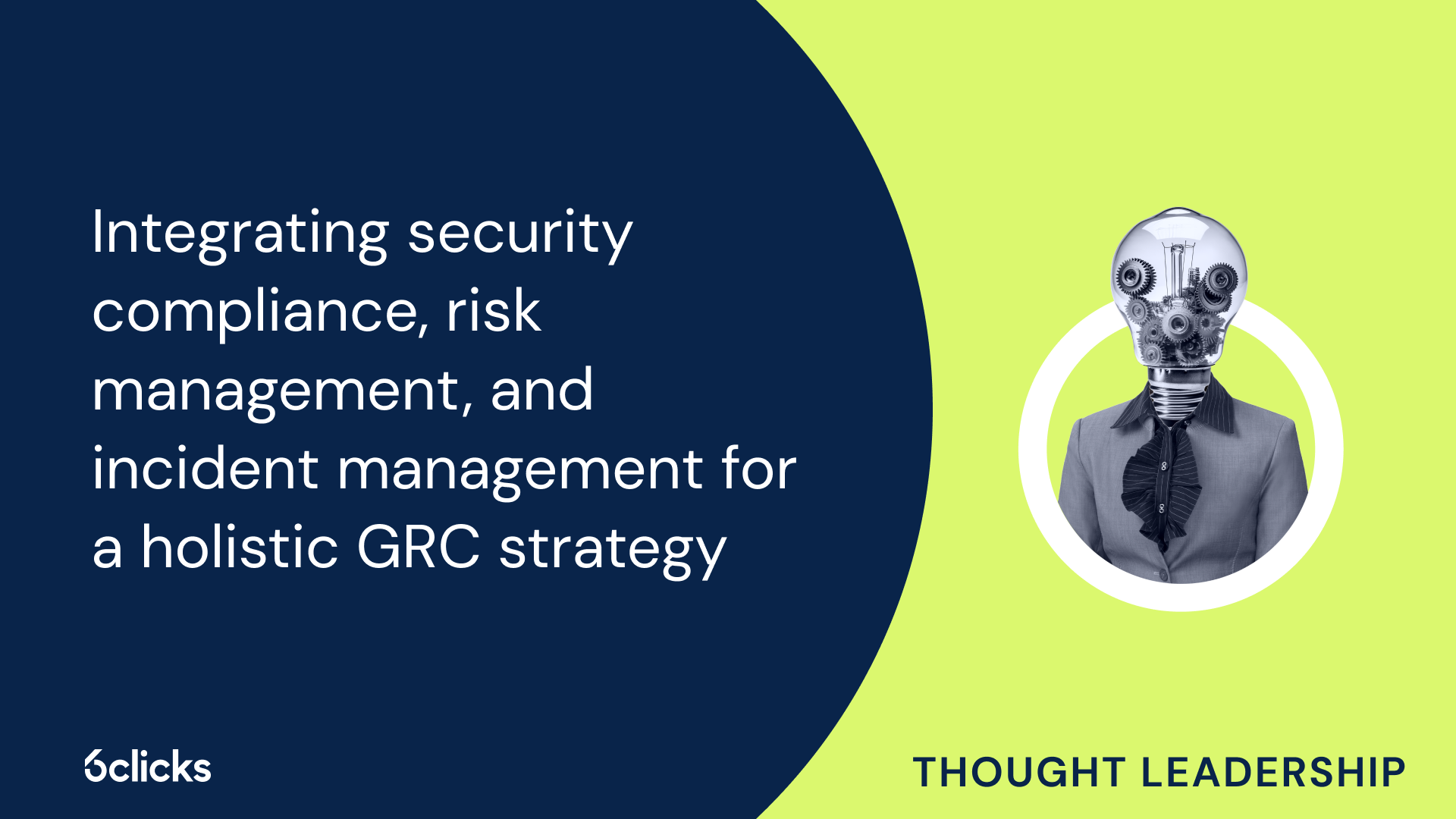
Keeping your organization secure from diverse threats and disruptions entails a holistic approach to governance, risk, and compliance. Security compliance, risk management, and incident management are interconnected disciplines that empower organizations to effectively address threats and incidents, maintain the security and legality of their operations, and achieve resilience. In this article, we will explore what these terms mean, their significance and components, and how they connect with one another.
What does security compliance entail?
Security compliance refers to the collective processes, systems, and policies that organizations have in place to safeguard their data and assets and meet industry standards and regulatory requirements. It involves establishing, documenting, and communicating information security policies, conducting cybersecurity training, and implementing security measures to uphold compliance with relevant laws, regulations, and standards. Security compliance encompasses the following components:

- Regulatory compliance: Organizations are subject to compliance with jurisdictional laws and sector-specific regulations. Examples are the Information Security Manual (ISM) for the Australian defence industry and the European Union’s Digital Operational Resilience Act (DORA) for the financial sector.
- Standards and compliance frameworks: Aside from legislation, organizations must also align with best practices for managing risks and processing data securely. These include voluntary compliance frameworks and standards for cybersecurity and information security, such as ISO 27001, NIST CSF, and SOC 2.
- Internal policies and controls: Security compliance also involves adhering to internal policies in addition to regulatory requirements and compliance frameworks. Organizations can do this by enforcing security measures or controls such as data encryption, network segmentation, and incident reporting.
- Risk management: Regulations and standards like DORA and ISO 27001 share a common focus on risk management, making it integral to security compliance. Organizations must implement procedures such as risk assessments and risk treatment to effectively manage risks and maintain compliance.
- Audit and assessment: Monitoring the performance of controls and risk management procedures is also essential in security compliance. By conducting regular security assessments and undergoing internal and external audits, organizations can ensure the effectiveness of security and risk mitigation measures and verify their compliance.
Through security compliance, organizations can demonstrate their enhanced capability to protect their data, assets, and operations, thereby improving trust from customers, stakeholders, and regulators, while fostering growth and sustainability.
What are the components of risk management?
On the other hand, risk management pertains to the process of identifying, evaluating, prioritizing, and then preventing, mitigating, or resolving risks that can negatively impact an organization. Organizations face various types of risks ranging from cyber risks, business risks, and financial risks to natural disasters and human error. Risk management provides a comprehensive framework that enables organizations to address diverse threats and vulnerabilities, prevent or prepare for incidents, and strengthen their security posture. Its components include:

- Risk identification: The process of identifying risks relevant to your organization and their potential impacts. This involves an in-depth analysis of your organizational context, which includes internal factors such as assets, human resources, and operations as well as external factors like location, industry, and customers.
- Risk assessment: Conducting a risk assessment comprises measuring and evaluating the likelihood and impact of identified risks. This enables organizations to determine which risks to prioritize for treatment or mitigation.
- Risk prioritization: Based on their likelihood and impact, organizations can determine the severity of identified risks and define whether the risk level is high, moderate, or low. This forms an overall risk rating for identified risks which then serves as the basis for effective risk prioritization.
- Risk mitigation: A treatment decision must then be made for risks prioritized by the organization. An organization can choose to accept, avoid, mitigate, or resolve a risk. Risk treatment plans are then created to monitor, remediate, or reduce the likelihood and impact of these risks.
- Risk monitoring: Organizations must continuously assess identified risks and monitor risk treatment plans to ensure oversight of their threat landscape and maintain a strong risk posture.
Risk management not only enhances security but also enables better resource allocation and decision-making, facilitates compliance, and promotes business continuity.
What is an incident response plan?
Finally, incident management deals with identifying, analyzing, and responding to incidents, which are unplanned events that can cause problems or disruptions to an organization's operations or services. It is a process that usually involves IT or DevOps teams, but it has become a common practice in GRC. An incident response plan aims to manage the impact of incidents, minimize damage, and ensure the continued operation of critical systems and infrastructure during disruptions. Key components of incident management include:

- Incident detection: Organizations can proactively identify incidents by establishing incident reporting mechanisms or through monitoring tools like threat detection and response systems (TDR) that can automatically detect malicious activity.
- Incident analysis: Every incident must be thoroughly documented and then investigated to determine its root cause, impact, and potential solutions. Incident analysis also helps organizations identify trends and patterns in occurrences so they can implement or adjust incident response strategies.
- Incident prioritization: Incidents should be assigned priority levels based on the severity of their impact. Organizations must then focus their efforts and resources on resolving the most critical issues first.
- Resolution and recovery: Actions are then taken to resolve an incident swiftly and restore operations. Conducting a post-mortem review of the incident from detection to resolution is also necessary for preventing future occurrences.
- Communication: Proper disclosure of incident details and keeping employees, customers, and other stakeholders involved well-informed throughout the incident lifecycle are crucial aspects of incident management.
Overall, incident management fosters transparency within your organization and bolsters its resilience to issues and disruptions that could threaten its very existence.
How do they all fit together?
Tying it all together, security compliance, risk management, and incident management have interdependent relationships and cannot exist without each other.
The goal of security compliance is to equip organizations with proactive risk management and incident response capabilities. Compliance requirements dictate the security measures and controls an organization must implement. In turn, these controls help in mitigating risks and preventing incidents.
At the same time, risk management governs security compliance efforts by identifying the areas where the organization is most vulnerable and needs to focus its security measures and controls. It also supports strategic incident handling.
Lastly, effective incident response relies on an organization’s security compliance and risk management practices. Building an incident response plan is part of an organization’s compliance obligations while risk management informs the incident management process.
All in all, security compliance, risk management, and incident management are the building blocks of a successful GRC strategy, empowering organizations to meet regulatory requirements and address risks and incidents effectively.
Leverage 6clicks for integrated security compliance, risk management, and incident management
The 6clicks platform provides integrated functionalities for streamlining security compliance, risk management, and incident management for your organization.
Achieve multi-framework compliance with DORA, ISO 27001, NIST CSF, SOC 2, and other regulatory requirements through turnkey content such as authority documents, control sets, and audit and assessment templates. Then, set up, manage, and test the effectiveness of your controls using our control management and continuous monitoring features.
For risk management, facilitate risk identification and risk assessment with our built-in risk registers, ready-to-use risk libraries, and custom risk fields. Then, leverage automated workflows and task assignment functionality to easily create and track risk treatment plans.
Meanwhile, you can utilize our custom incident submission forms and incident registers to record, review, and prioritize incidents. Our built-in task management features, including our Jira integration, can then enable you to action and resolve incidents efficiently.
Learn how 6clicks can help your organization build a robust GRC strategy.


